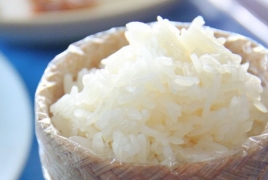 Empire built on riceThe Great Wall of China The Great Wall of China is a series of fortifications made of stone, brick, rammed earth, wood, and other materials, generally built along an east-to-west line across the historical northern borders of China to protect the Chinese states and empires against the raids and invasions of the various nomadic groups of the Eurasian Steppe. PanARMENIAN.Net - The Great Wall was continuously built from the 3rd century BC to the 17th century AD on the northern border of the country as the great military defense project of successive Chinese Empires, with a total length of more than 20,000 kilometers. The Great Wall begins in the east at Shanhaiguan in Hebei province and ends at Jiayuguan in Gansu province to the west. The Wall that stands for over 2000 years is a symbol of national defense. An ancient Chinese saying goes: “A home is incomplete without a wall.” Other purposes of the Great Wall have included border controls, allowing the imposition of duties on goods transported along the Silk Road, regulation or encouragement of trade and the control of immigration and emigration. Furthermore, the defensive characteristics of the Great Wall were enhanced by the construction of watch towers, troop barracks, garrison stations, signaling capabilities through the means of smoke or fire, and the fact that the path of the Great Wall also served as a transportation corridor. In 2010, Chinese scientists found that the secret of the strength and longevity of the Great Wall of China lies in the sticky rice that was used as its mortar. They also concluded that the mortar ― a paste used to bind and fill gaps between bricks, stone blocks and other construction materials ― remains the best available material for restoring ancient buildings. After a five-year survey of the Wall, Bingjian Zhang, Ph.D., from Zhejiang University, and his colleagues said that construction workers in ancient China developed sticky rice mortar about 1,500 years ago by mixing sticky rice soup with the standard mortar ingredient. That ingredient is slaked lime, limestone that has been calcined, or heated to a high temperature, and then exposed to water. Sticky rice mortar probably was the world's first composite mortar, made with both organic and inorganic materials. The mortar was stronger and more resistant to water than pure lime mortar, and what Zhang termed one of the greatest technological innovations of the time. Builders used the material to construct important buildings like tombs, pagodas, and city walls, some of which still exist today. Some of the structures built during the Ming Dynasty (1368 to 1644) were strong enough to shrug off the effects of modern bulldozers and powerful earthquakes. Their research identified amylopectin, a type of polysaccharide, or complex carbohydrate, found in rice and other starchy foods, as the "secret ingredient" that appears to be responsible for the mortar's legendary strength. “Analytical study shows the ancient masonry mortar is a kind of special organic-inorganic composite material. The inorganic component is calcium carbonate, and the organic component is amylopectin, which comes from the sticky rice soup added to the mortar,” the scientists said. “Moreover, we found that amylopectin in the mortar acted as an inhibitor: the growth of the calcium carbonate crystal was controlled, and a compact microstructure was produced, which should be the cause of the good performance of this kind of organic-organic mortar. The test results of the modeling mortars shows that sticky rice-lime mortar has more stable physical properties, has greater mechanical strength, and is more compatible, which make it a suitable restoration mortar for ancient masonry.” To determine whether sticky rice can aid in building repair, the scientists prepared lime mortars with varying amounts of sticky rice and tested their performance compared to traditional lime mortar. Sticky rice, the study authors note, has already been successfully used in recent conservation projects, such as at the 800-year-old Shouchang Bridge in eastern China. Besides, the results of the study suggest sticky-rice mortars become stronger over the years, because the key chemical reactions in the mortar continue to occur. Lusine Mkrtumova / PanARMENIAN.Net How collection of horned creatures turned into museum New York’s first female crime boss World’s largest boneyard An Italian photojournalist’s journey through the pandemic Quarantine in metropoles Town without newborns and dead Nine months in the Pacific |